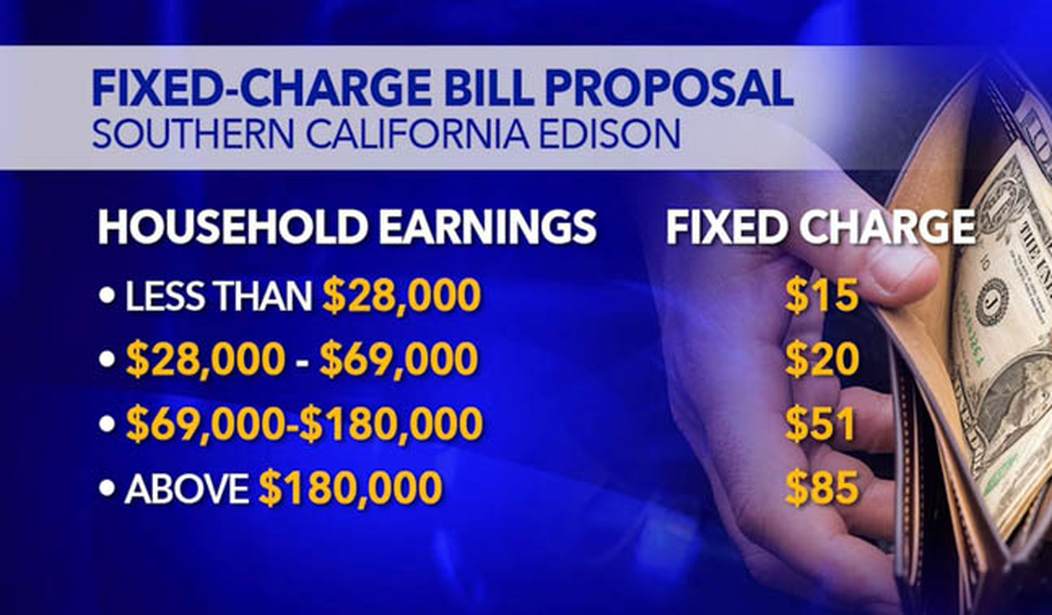California’s three largest power companies have put forward a new plan for how homeowners will pay their energy bills. The general idea is that the cost of the actual electricity you use each month will be separated from the “infrastructure charge,” i.e. the cost of maintaining and building the grid that delivers that electricity. Users will pay a smaller fee for the actual amount of electricity they use but al larger, fixed monthly fee for maintaining the grid.
And here’s where California seems to have borrowed its plan directly from Karl Marx. The new proposals suggests four separate tiers of monthly payments which are based entirely on income. The more you make the more you’ll pay to maintain the grid, regardless of how much energy you use.
Under the proposal, households will see a fixed rate covering basic electricity services and the utility company’s operating costs on a scale based on their household income.
- Households with annual income from $28,000 – $69,000 would pay $20 a month in Edison territory, $34 a month in SDG&E territory and $30 a month in PG&E territory.
- Households earning from $69,000 – $180,000 would pay $51 a month in Edison and PG&E territories and $73 a month in SDG&E territory.
- Those with incomes above $180,000 would pay $85 a month in Edison territory, $128 a month in SDG&E territory and $92 a month in PG&E territory.
This leaves out a lower tier where people pay $15 per month. In any case this plan where you pay for the grid based on income rather than usage comes not from Karl Marx but from a UC Berkeley economist named Severin Borenstein.
In 2021 Borenstein put forward a report which noted that high income households “consume only slightly more (net) electricity from the grid than poorer households.” That’s bad because it means those with higher incomes aren’t paying all that much more than those with lower incomes for electricity.
The more equitable solution according to Borenstein and his co-authors was income-based bills. He wrote, “income-based fixed charges would improve equity by lightening the burden of cost recovery on households that can least afford to pay.”
All of this is tied in to California’s efforts to encourage the adoption of rooftop solar with something called Net Metering. If you’re interested in the details you can read this previous post but the gist is that more than a million Californians signed up for a deal called Net Metering 2.0 which meant the state paid the homeowner for any extra electricity they generated but didn’t use. When Net Metering first started this was a big inducement to get people to sign up for solar. But as the cost of solar has come down, so many people took the deal that many of the state’s biggest electricity users suddenly became net electricity generators or very close to it. In other words, instead of getting money from these homeowners the electric utilities were, in some cases, paying them.
So the question became how to get more money out of those people, most of whom were upper income, who’d effectively stopped paying the utilities for electricity. The first proposal for a revised plan called Net Metering 3.0 was to charge people who owned solar panels a monthly fee for owning them. That fee was just a way to gouge those who had escaped the clutches of the utility companies. It was so unpopular that even California’s green former governor Arnold Schwarzenegger came out against it.
The state utilities board went back to the drawing board and passed a different version of Net Metering 3.0, which took effect Saturday. The new plan essentially reduces the amount that utilities pay rooftop solar generators by about 75%. So before it might have taken 5-6 years for a rooftop system to pay for itself, now it will be quite a bit longer, maybe 18-20 years. At that point it’s barely worth doing.
And if this new plan for a fixed monthly fee based on income does happen, (it’s expected to roll out in 2025) there would be even less incentive to install solar anymore. Why bother if you’ll still going to be forced to pay the utility $500 or $1000 a year (for equity) even if you’re producing more electricity than you use in a given year.
We’ll see what happens but it looks to me like California is going to drive the rooftop solar industry out of business.
Finally, one more local report. I’ve cued this up to a man who pointed out the state, at present, has no way to verify your income. Apparently the plan is to create a new agency that would do that so they know how much equity you can afford.








Join the conversation as a VIP Member